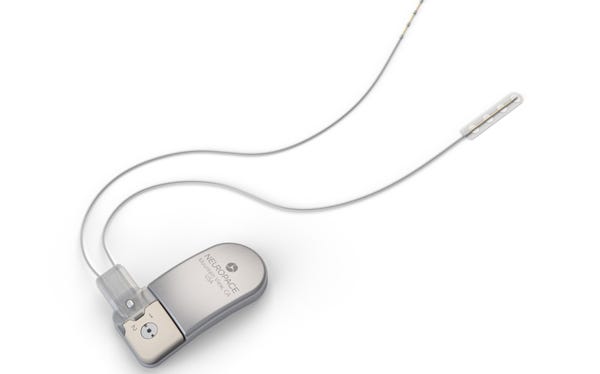How a Neurostimulator Can Also Advance Science
April 12, 2016
NeuroPace's RNS System for treating seizures is also providing insights that could advance understanding of epilepsy, a scientist with the company explained Tuesday at the Design of Medical Devices Conference in Minneapolis.
Chris Newmarker
|
The RNS System includes a small, implantable neurostimulator connected to leads placed in up to two seizure onset areas. (Image courtesy of NeuroPace) |
The medical device industry trend of pacemaker technology being increasingly applied to neurological problems could have an added benefit: better scientific understanding of the disorders the devices are supposed to treat.
NeuroPace's RNS System, approved by FDA in 2013 for reducing the frequency of epileptic seizures in severe cases, has shown itself able to reduce seizures by 60% over three years. It is already providing some important insights about epilepsy, according Ritu Kapur, PhD, a senior clinical research scientist at the company.
Patients using the system are able to wave a wand over where the device is implanted in their heads in order to download information, including the electronic brain signals around an event with the device. Health providers are able to view the data remotely over the RNS System's patient data management system.
"One of the things that's nice about this is the doctors can review the patient's data without the patient having to come in and sit in front of them," Kapur said Tuesday at the Design of Medical Devices Conference at the University of Minnesota in Minneapolis.
The data is usually for only about 6 minutes per day at a sampling frequency of 250 Hz, but it has already proved highly actionable in some cases.
In one instance reported by Cleveland Clinic and recounted by Kapur, a 33-year-old woman with epilepsy had landed in the ER three times in one year. The data from the NeuroPace device implanted in her showed a marked increase increase in unusual brain activity on Fridays, Saturdays, and Sundays. Eventually, the increased seizures were linked to the 2 L of caffeinated soda she was drinking over the weekend in lieu of alcohol.
Kapur thought it a great example of how information from the RNS System can work in synergy with information clinicians would gather traditionally.
Some other insights gleaned so far through RNS System data include:
Electrographic 'events' are far more common than actual clinical seizures. A person may only record two seizures in a month, but it is common for the RNS System to record about 300 electrographic events per month. "What this tells us is that there's activity that has an electrophysiological signature that looks very similar," Kapur says.
The brain is not binary. There are electrical signals interictal, falling in between a seizure signal and no seizure signal.
There are rhythms to seizure activity. Kapur recounted one study: "Some circadian, some ultradian. But no one was arrhythmic."
Kapur suspects more sampling frequencies could provide even more clinical insights. More leads could provide better pinpointing of where in the brain seizures are taking place, helping physicians determine where a potential surgery needs to take place.
But Kapur is also humbled when it comes to figuring out what type of information clinicians actually need, versus simply designing a device that is able to sense and record more: "What do the doctors need the most? When the patient sits down, what do they wish they know?"
Learn more about cutting-edge medical devices at BIOMEDevice Boston, April 13-14, 2016. |
About the Author(s)
You May Also Like



